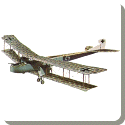 Gotha G.V — The German World War I Gotha G.V., with a range of more than 800 km (500 mi) and speed less than 160 km/h (100 mph), carried six 50-kg (100-lb) bombs.
Gotha G.V — The German World War I Gotha G.V., with a range of more than 800 km (500 mi) and speed less than 160 km/h (100 mph), carried six 50-kg (100-lb) bombs.
The Gotha G series was a family of heavy bombers used by the Luftstreitkrafte (Imperial German Air Service) during the First World War. There were five basic variants, designated G.I through G.V. It is known for its air raids on London, to that degree that other German bombers were incorrectly referred to as Gothas, e.g. the AEG G.IV or the Zeppelin Staaken R.VI.
Gotha G.I
In 1914, Oskar Ursinus, the founder and editor of the German flying magazine Flugsport, began designing a large twin-engine seaplane. Ursinus was conscripted into the army in the summer of 1914. In conjunction with military personnel, Ursinus adapted his seaplane design into a Kampfflugzeug (“battle aircraft”) intended for ground attack duties. Due to its seaplane heritage, it featured a slender fuselage attached to the upper wing. This unusual arrangement provided excellent views for the three crewmen and broad fields of fire for the gunner. The two 100 hp Benz Bz. II engines were set very close together on the lower wing, thereby minimizing asymmetrical thrust in the event of an engine failure. The engines and crew were protected by 200 kg (440 lb) of armor.
The prototype, which first flew in January 1915, was difficult to fly, lacking in structural integrity, dangerous to the crew in the event of a crash landing, and underpowered. Nevertheless, the Idflieg issued a contract for series production to Gothaer Waggonfabrik AG, which acquired a license from Ursinus. Gothaer chief engineer Hans Burkhard simplified and refined the design, which was originally known as the “Gotha-Ursinus-Heeresflugzeug,” or “GUH,” later known as the Gotha G.I or Gotha-Ursinus G.I. The first production aircraft was completed in late July 1915. These aircraft were powered by two 150 hp Benz. Bz. III engines. Gothaer Waggonfabrik built about 20 G.I aircraft before production ceased at the end of the year.
Gotha G.II
The succeeding Gotha G.II was an entirely new biplane designed by Hans Burkhard. It carried a crew of three and a defensive armament of two machine guns. The forward section of the fuselage was skinned in plywood, with the remainder covered in fabric. The fuselage and two very large nacelles were mounted on the lower wing. Each nacelle contained fuel tanks and oil tanks beneath a geared eight-cylinder 220 hp Mercedes D.IV, a derivative of the Mercedes D.III with two additional cylinders.
The G.II prototype first flew in March 1916. After testing, the design was revised to incorporate a larger three-bay wing, horn-balanced ailerons, modified undercarriage, and a triangular vertical fin. In this configuration, production commenced in April 1916. The G.II entered operational service in the autumn, but was withdrawn from operations in the spring of 1917 after repeated failures of the engine crankshafts. Only 10 G.II aircraft were built.
Gotha G.III
The G.II was succeeded by the G.III, which featured a reinforced fuselage with an extra machine gun firing through a ventral trapdoor. The failed eight-cylinder Mercedes D.IV was replaced by the new six-cylinder 260 hp Mercedes D.IVa engine. Most of the 25 G.III aircraft produced were delivered to Kagohl 1, operating in the Balkans. Combat service of the G.III was limited but effective. Its most notable accomplishment came in September 1916, when a formation of G.III aircraft destroyed the railway bridge over the Danube River at Chernavoda, Romania. In September 1917, all surviving aircraft were withdrawn from combat and relegated to training units.
Gotha G.IV
The cockpit of a Gotha G.IV Experience with the G.III showed that the rear gunner could not efficiently operate both the dorsal and ventral positions. Hans Burkhard’s ultimate solution was the “Gotha tunnel,” a trough connecting an aperture in the upper decking with a large opening extending across the bottom of the rear fuselage. The Gotha tunnel allowed a gunner at the dorsal position to depress his gun into the aperture and fire through the fuselage at targets below and behind the bomber. A ventral machine gun could still be mounted.
The G.IV introduced other changes. The fuselage was fully skinned in plywood, eliminating the partial fabric covering of the G.III. Furthermore, complaints of poor lateral control, particularly on landing, led to the addition of ailerons on the lower wing.
In November 1916, Gothaer received a production order for 35 aircraft; this was subsequently increased to 50 in February 1917. A further 80 aircraft were ordered from the Siemens-Schuckert Werke (SSW) and 100 from Luft-Verkehrs-Gesselschaft (LVG). These license-built aircraft were slightly heavier and slower than the Gothaer aircraft because the Idflieg specified the use of a strengthened airframe.
In March 1917, the G.IV entered service with Kagohl 1, which was redesignated Kagohl 3 upon receipt of the new machines.
Gotha G.V
Operational use of the G.IV demonstrated that the incorporation of the fuel tanks into the engine nacelles was problematic. In a crash landing, the tanks could rupture and spill fuel onto the hot engines. Since landing accidents constituted 75 percent of all operational losses, this problem demanded immediate attention. In response, Gothaer produced the G.V, which housed its fuel tanks in the center of the fuselage. The smaller engine nacelles were mounted on struts above the lower wing.
The G.V entered service in August 1917. It offered no performance improvement over the G.IV. Indeed, the G.V was up to 450 kg (992 pounds) heavier than the G.IV due to additional equipment and the use of insufficiently seasoned timber. Furthermore, inferior quality fuel prevented the Mercedes D.IVa engines from producing the rated 260 hp. For these reasons, the G.V generally operated at much lower altitudes than the G.IV.
The Gotha bombers exhibited marginal directional control in single-engine conditions. In February 1918, Gothaer tested a compound tail unit with biplane horizontal stabilizers and twin rudders. The new tail unit, known as the Kastensteuerung, allowed the G.V to fly in a straight line with a single engine at full power. The resulting subvariant, designated G.Va, incorporated the new tail as well as a slightly smaller nose section with an auxiliary nose landing gear. All 25 G.Va aircraft were delivered to Bogohl 3, the new designation for the former Kagohl 3.
The G.Va was replaced in production by the G.Vb, which carried an increased payload and operated at a maximum takeoff weight of 10,031 lb (4,550 kg). To reduce the danger of flipping over during landing, Gothaer introduced the Stossfahrgestell (“shock landing gear”), a tandem two-bogie main landing gear. The Stossfahrgestell proved so effective that it was retrofitted to all G.V aircraft serving with Bogohl 3. Some G.Vb aircraft also had Flettner servo tabs on the ailerons to reduce control forces.
Idflieg ordered 80 G.Vb aircraft, the first being delivered to Bogohl 3 in June 1918. By the Armistice, all 80 aircraft had been completed, but the last batch did not reach the front and was instead delivered directly from the factory to the Allied special commission.
Operation
Contemporary illustration of a Gotha crew in action In late 1916, Germany began planning a daylight bombing offensive against England, designated Operation Türkenkreuz. In anticipation of the campaign, Kagohl (Kampfgeschwader der Obersten Heeresleitung) 3, comprising six Kastas (Kampfstaffel) under the command of Hauptmann Ernst Brandenburg, was formed.
Known informally as the Englandgeschwader, Kagohl 3 operated from St. Denis-Westrem and Gonterode, in the Ghent area of German-occupied Belgium. British raids on these bases forced Kagohl 3 to move to Mariakerke and Oostracker. In March and April of 1917, the unit equipped with the first batch of Gotha G.IV aircraft.
On May 25, 1917, Kagohl 3 sortied 23 Gothas for a daylight raid on London, but two were forced to turn back over the North Sea due to mechanical difficulties. Poor weather forced the remaining bombers to divert to secondary targets at the Channel port of Folkestone and the nearby Army camp at Shorncliffe. The raid resulted in 95 deaths and 195 injuries, mostly in the Folkestone area. Nine RNAS Sopwith Pups engaged the returning bombers near the Belgian coast, shooting one down.
On June 13, 1917, 18 Gotha bombers carried out the first daylight raid on London, causing 162 deaths and 432 injuries. Among the dead were 46 children killed by single bomb falling on a kindergarten in Poplar. This was the deadliest air raid of the war. No bombers were shot down. In 1938 Air Commodore Lionel Charlton, in an analysis predicting the crucial imporatnce which bombing civilian populations would have in the then impending WWII, called June 13, 1917 “a date marking the beginning of a new epoch in the history of warfare”.
On July 7, 1917, 20 Gothas again attacked London, resulting in 54 deaths and 190 injuries. Many of these casualties were caused by falling anti-aircraft shells. One aircraft was shot down.
Between May and August 1917, Kagohl 3 carried out eight daylight raids over England, including three raids on London. Beginning in September, improved British air defenses forced Kagohl 3 to abandon daylight raids. While night raids provided a measure of protection from interceptors and anti aircraft fire, they greatly complicated navigation and landing. Many damaged aircraft limped back to their airfields, only to be lost in landing accidents.
In December 1917, Kagohl 3 was redesignated Bogohl (Bombengeschwader der Obersten Heeresleitung) 3. Unlike other Boghohls, which consisted of only three Bostas (Bombenstaffel), Bogohl 3 retained its original strength of six staffels. Continued heavy losses forced Bogohl 3 to stand down from combat operations in February 1918.
On the night of May 19, 1918, the Gothas returned to England for the last and largest raid of the war. Bogohl 3 sortied 38 Gothas against London, but suffered heavy losses in the process. Six Gothas were shot down by interceptors and anti-aircraft fire, while a seventh aircraft was lost in a landing accident. After this raid, Gothas operated as tactical bombers against targets on the Western Front.
Gothas carried out a total of 22 raids on England, dropping 186,830 lb (84,745 kg) of bombs for the loss of 61 aircraft.
 Kids Portal For Parents India Kids Network
Kids Portal For Parents India Kids Network
